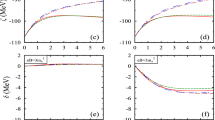Summary
Thermodynamical relations in quantum field theory will be discussed. This gives a possibility to decide whether or not the interactions are renormalizable, i.e., of the first or the second kind. The renormalization procedure is elucidated by formulating the perturbational calculation. The possibility for proceeding to the non-perturbational method is also pointed out. These general considerations are applied to find out the interaction effects in the multiple production phenomena, which have been disregarded in Fermi-Landau’s statistical theory.
Riassunto
Si discutono le relazioni termodinamiche nella teoria quantistica dei campi. È offerta così la possibilità di decidere se le interazioni siano rinormalizzabili o meno, cioè se siano di prima o di seconda specie. Si illustra il procedimento di rinormalizzazione formulando il calcolo perturbativo. Si mette anche in evidenza la possibilità di procedere con metodo non perturbativo. Queste considerazioni d’indole generale si applicano alla ricerca degli effetti d’interazione nei fenomeni di produzione multipla, effetti che furono trascurati nella teoria statistica di Fermi-Landau.
Similar content being viewed by others
References
E. Fermi:Progr. Theor. Phys.,5, 570 (1950);Phys. Rev.,81, 683 (1951).
Nishimura: Private communication.
L. D. Landau:Izv. Akad. Nauk SSSR, Ser. Fiz.,17, 51 (1953).
T. Matsubara:Prog. Theor. Phys.,14, 351 (1955).
A. E. Scheidegger andC. D. McKay:Phys. Rev.,83, 125 (1951).
S. Sakata, H. Umezawa andS. Kamefuchi:Prog. Theor. Phys.,7, 377 (1952);W. Heisenberg,Solvay Ber., Kap. III, IV (1939).
G. C. Wick:Phys. Rev.,80, 268 (1950).
H. Umezawa andA. Visconti:Nuclear Physics,1, 348 (1956);Y. Takahashi andH. Umezawa:Prog. Theor. Phys.,9, 14 (1953).
It is not so serious that we must replaceω k →iω k to make our propagation functions coincide with those of Feynman in the limitβ → ∞. In the (k,k 0) space integration now concerned, if we change the contour ofk 0-integration from the real to the imaginary axis, we get the same integrand as in theS-matrix theory. And, this change of contour can be done without crossing undisplaced poles. Moreover, it has been known that the contribution from displaced poles is finite. See,R. J. Eden:Proc. Roy. Soc., A210, 388 (1952).
W. Thirring:Helv. Phys. Acta,26, 33 (1953);A. Peterman:Helv. Phys. Acta,26, 465 (1953).
Path integral method in quantum statistics has been applied byFeynman (Phys. Rev.,91, 1291 (1953)) to the problem of Liquid Helium, where the particles interact with each other through the potential interaction.
H. Umezawa andA. Visconti:Nuovo Cimento,1, 1079 (1955).
R. E. Peierls:Phys. Rev.,54, 918 (1938).
Author information
Authors and Affiliations
Rights and permissions
About this article
Cite this article
Ezawa, H., Tomozawa, Y. & Umezawa, H. Quantum statistics of fields and multiple production of mesons. Nuovo Cim 5, 810–841 (1957). https://doi.org/10.1007/BF02903206
Received:
Published:
Issue Date:
DOI: https://doi.org/10.1007/BF02903206




